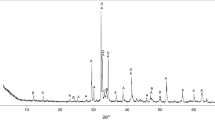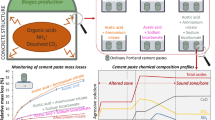Abstract
Agriculture produces effluents, like liquid manure and ensilage effluents, that cause serious environmental problems. In order to limit this pollution, manure needs to be stored in water-tight silos often made of concrete. Manure contains organic acids which constitute a severe chemical threat for concrete.
This research aims to analyze the degradation mechanisms of cement-based materials stored in organic acids. The results are used to identify the composition parameters of binders that influence durability. Ordinary and blended Portland cement specimens were immersed for 18 weeks in a mixture of 5 organic acids found in liquid manure at a pH of 4.
Physical, chemical and mineralogical modifications in the pastes were explored by water intrusion porosity tests, electron microprobe and X-ray diffraction analyses. Analyses were run from the sound to the altered zone. The altered depths and the mass loss variations of the samples were monitored over time.
The degradation of the matrix occurs by almost total decalcification, the vanishing of the crystallized or amorphous hydrated phases and the probable formation of a silica gel, which limits the kinetics of further degradation. In the altered zone, the anhydrous silico-calcic grains are chemically modified but C4AF and slag grains keep their initial composition.
Similar content being viewed by others
References
Salmon-Legagneur E, Bernard CR (1975) Composition minérale des lisiers de porcs, valeur agronomique. Journées de la Recherche Porcines en France, 323–330.
Williams AG (1983) Organic acids, biochemical oxygen demand and chemical oxygen demand in the soluble fraction of piggery slurry. J Sci Food Agric. 34:212–220.
Weast RC, Astel MJ, Beyer WH (1986) CRC handbook of chemistry and Physics. 67th Edn (CRC Press Inc., Boca Raton, Florida).
European Standard NF EN 197-1 (February 2001) AFNOR, Paris, France.
Bertron A, Duchesne J, Escadeillas G (2005) Attack of cement pastes exposed to organic acids in manure. Cement Concrete Comp., 27 (9–10):898–909.
Harris AW, Manning MC, Tearle WM, Tweed CJ (2002) Testing of models of the dissolution of cements –leaching of synthetic CSH gels. Cement Concrete Res., 32(5):731–746.
Richardson IG (1999) The nature of C-S-H in hardened cements. Cement and Concrete Res 29:1131–1147.
Richardson IG, Groves GW (1993) ‘The incorporation of minor and trace elements into calcium silicate hydrate (C-S-H) gel in hardened cement pastes. Cement Concrete Res., 23:131–138.
Hong SY, Glasser FP (1999) Alkali binding in cement pastes. Part I. The C-S-H phase. Cement Concrete Res., 29:1893–1903.
Kalousek GL (1944) Studies of quaternary system soda-lime-silica-water at 25∘C. Journal res National Bureau of Standards, 32: 285–302.
Bhatty MSY (1985) Mechanism of pozzolanic reactions and control of alkali-aggregate expansion. Cement Concrete Aggr., 7(2):69–77.
Author information
Authors and Affiliations
Rights and permissions
About this article
Cite this article
Bertron, A., Duchesne, J. & Escadeillas, G. Degradation of cement pastes by organic acids. Mater Struct 40, 341–354 (2007). https://doi.org/10.1617/s11527-006-9110-3
Received:
Accepted:
Published:
Issue Date:
DOI: https://doi.org/10.1617/s11527-006-9110-3




